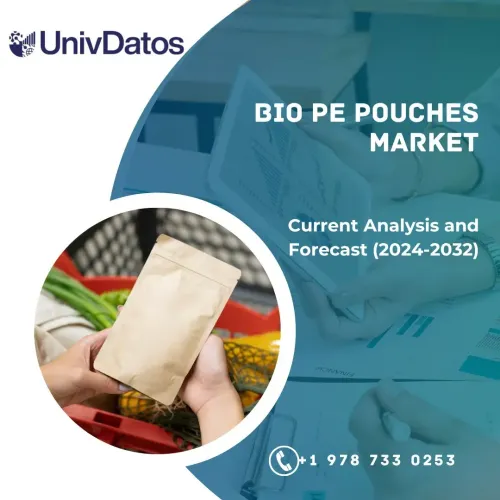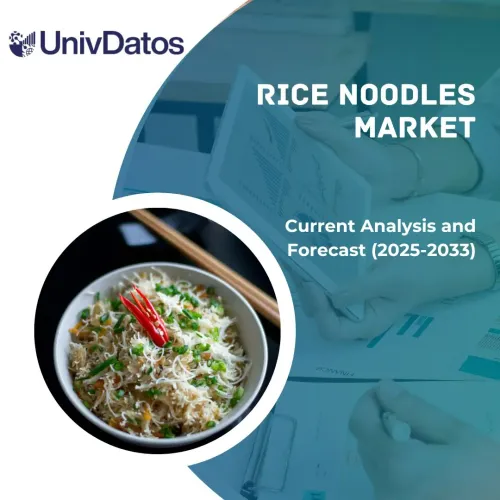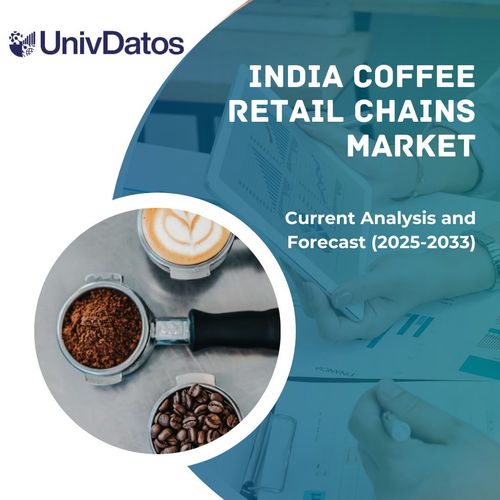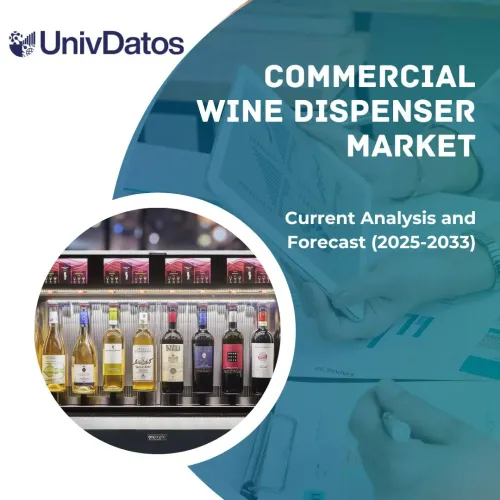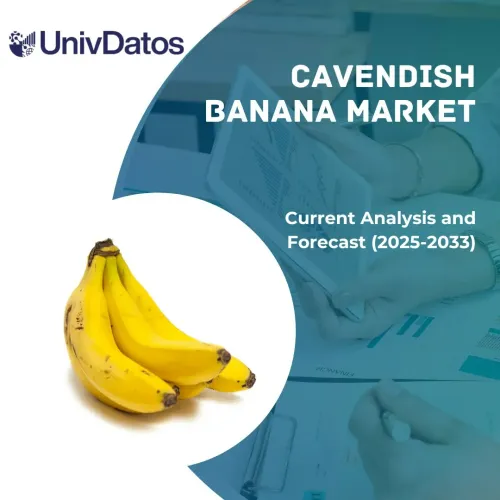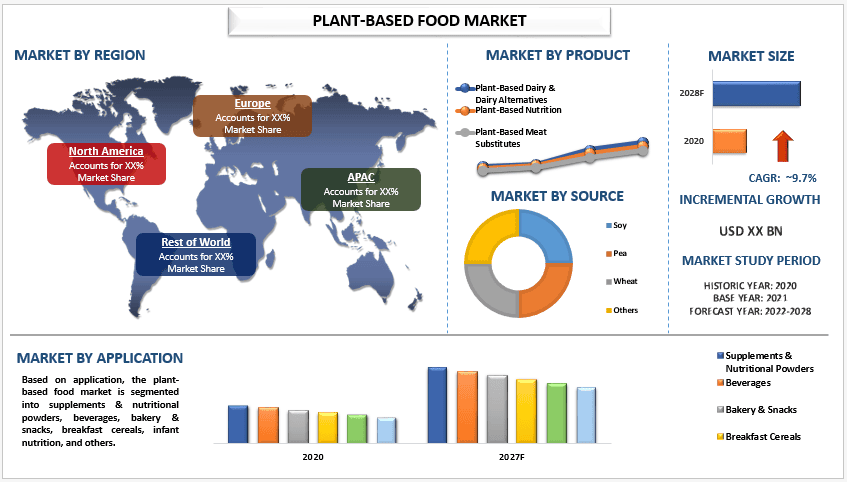
글로벌 식물 기반 식품시장은 2020년에 252억 달러로 평가되었으며 2022-2028년 동안 연평균 성장률(CAGR) 9.7%로 성장할 것입니다.식물 기반 식품 산업의 성장의 주요 요인은 소비자의 윤리적 관심 증가입니다. 이는 부분적으로 밀레니얼 세대와 ‘플렉시테리언’ 소비자의 등장에 의해 주도됩니다. 또한, 식물 기반 식품의 특정 성분은 종종 소비자에 높은 수준의 단백질과 영양가를 제공하는 것으로 확인됩니다(예: 대두, 귀리, 코코넛, 아몬드, 쌀, 삼 등).또한, 동물 복지 단체가 상당한 견인력을 얻었고 제품 생산에서 동물이 대우받는 방식이 소비자의 식물 기반 식품 선호도 변화를 야기했습니다.
또한, 식물 기반 식품 시장은 냉장, 상온, 냉동 부문에서 혁신적인 제품에 대한 수요 증가로 인해 새로운 제품 개발이 크게 증가하면서 가속화된 속도로 성장할 것으로 예상됩니다. 따라서 소비자에게 더 넓은 범위의 제품과 브랜드를 제공하고 식물 기반 식품 산업이 향후 몇 년 동안 다양한 성장 기회를 갖도록 합니다.예: 2022년 11월, Beyond Meat, Inc.는 beyond 팝콘 치킨과 beyond 치킨 너겟을 출시했습니다.
Amy’s Kitchen Inc., Atlantic Natural Foods LLC, Beyond Meat Inc, Danone SA, Garden Protein International Inc., Impossible Foods Inc., Light life Foods Inc. (Maple Leaf Foods Inc.), Nestle S.A., Tyson Foods Inc., V bite Food Ltd.
보고서에 제시된 통찰력
“제품 중, 식물 기반 유제품 및 유제품 대체품 카테고리는 예측 기간 동안 강력한 연평균 성장률(CAGR)을 기록할 것입니다.”
제품을 기반으로 식물 기반 식품 시장은 식물 기반 유제품 및 유제품 대체품, 식물 기반 영양, 식물 기반 육류 대체품으로 세분화됩니다. 식물 기반 유제품 및 유제품 대체품 부문이 상당한 시장 점유율을 차지합니다. 아몬드 우유, 귀리 우유와 같은 식물 기반 유제품 대체품은 질감으로 인해 소비자 사이에서 수요가 증가하고 있으며, 다른 식물 기반 제품보다 더 두껍고 크리미하여 음료와 식품 모두에 적합합니다. 또한 유당 불내증 환자도 동물성 유제품 없는 요구르트, 디저트, 치즈와 같은 식물 기반 유제품을 채택하고 있으며, 아기의 새로운 영양 프로필, 맛 및 질감을 제공하는 혼합 우유 제품 출시는 식물 기반 식품 시장 규모를 견인하고 있습니다.예: 2022년 7월 5일, Danone은 아기를 위한 채식주의자 및 플렉시테리언 옵션을 위해 최초의 유제품 및 식물 혼합 유아용 조제 분유를 출시했습니다.
“원료 중, 대두 카테고리는 예측 기간 동안 강력한 연평균 성장률(CAGR)을 기록할 것입니다.”
원료를 기반으로 식물 기반 식품 시장은 대두, 완두, 밀 및 기타로 세분화됩니다. 대두 부문은 식물 기반 식품 시장에서 가장 높은 점유율을 차지했습니다. 대두와 대두 식품은 단백질 함량이 높고 육류 유사체 및 우유 대체품 생산에 다용도로 사용되어 채식주의자에게 흔한 영양 솔루션입니다. 또한, 대두는 단백질이 풍부하고 불포화 지방, 철분 및 비타민 B1을 함유하고 있어 식물 기반 제품에 유용합니다. 또한, 다양한 주요 업체가 식물 기반 식품 시장에서 100% 대두 스낵 및 음료를 출시하여 시장에서 기회를 창출할 것입니다.예: 2022년 3월, Otsuka Pharmaceutical Co., Ltd. (Otsuka)는 맛있고 편리한 통대두 영양 바 SOYJOY 라인의 새로운 시리즈인 SOYJOY Plant-Based를 일본 전역에 두 가지 맛(화이트 초콜릿 및 바나나)으로 출시한다고 발표했습니다.
“북미 지역이 시장에서 상당한 점유율을 차지할 것입니다.”
북미 지역은 예측 기간 동안 상당한 연평균 성장률(CAGR)로 성장할 것으로 예상됩니다. 이는 주로 계란 대체품, 식물 기반 우유, 식물 기반 육류 대체품과 같은 새로운 제품의 개발 및 인기로 인해 식물 기반 식품에 대한 소비자의 수용이 증가하면서 이 지역의 식물 기반 식품 시장 규모를 확대하고 있기 때문입니다. 또한, 미국 내 비건 및 플렉시테리언 인구 증가와 주요 식물 기반 식품 제조 회사의 강력한 존재가 시장 성장을 주도하고 있습니다.예를 들어, Vegetarian Times의 연구에 따르면 미국인 970만 명이 채식 식단을 따르고 있으며, 그 중 거의 100만 명이 비건입니다. 미국에서 식물 기반 식품 소비자의 59%는 여성이고 41%는 남성입니다..
식물 기반 식품 시장 보고서 범위
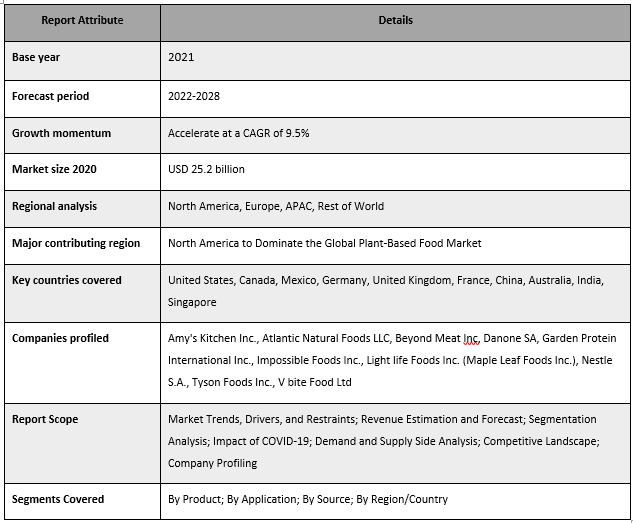
이 보고서를 구매해야 하는 이유:
- 이 연구에는 인증된 주요 업계 전문가가 검증한 시장 규모 측정 및 예측 분석이 포함되어 있습니다.
- 이 보고서는 전체 산업 성과를 한눈에 빠르게 검토하여 제공합니다.
- 이 보고서는 주요 비즈니스 재무, 제품 포트폴리오, 확장 전략 및 최근 개발에 중점을 두고 주요 업계 동료에 대한 심층적인 분석을 다룹니다.
- 업계에서 우세한 동인, 제약, 주요 트렌드 및 기회에 대한 자세한 조사.
- 이 연구는 다양한 부문에 걸쳐 시장을 포괄적으로 다룹니다.
- 산업에 대한 심층적인 지역별 분석.
맞춤화 옵션:
글로벌 식물 기반 식품 시장은 요구 사항 또는 기타 시장 부문별로 추가 사용자 정의할 수 있습니다. 이 외에도 UMI는 귀하의 고유한 비즈니스 요구 사항을 이해하므로 귀하의 요구 사항에 완벽하게 맞는 보고서를 얻기 위해 언제든지 저희에게 연락하십시오.
목차
식물 기반 식품 시장 분석을 위한 연구 방법론 (2022-2028)
과거 시장 분석, 현재 시장 추정, 글로벌 식물 기반 식품 시장의 미래 시장 예측은 주요 지역에서 식물 기반 식품의 채택을 생성하고 분석하기 위해 수행된 세 가지 주요 단계였습니다. 과거 시장 수치를 수집하고 현재 시장 규모를 추정하기 위해 광범위한 2차 조사가 수행되었습니다. 둘째, 이러한 통찰력을 검증하기 위해 수많은 결과와 가정이 고려되었습니다. 또한, 글로벌 식물 기반 식품 시장의 가치 사슬 전반에 걸쳐 업계 전문가와의 광범위한 1차 인터뷰도 수행되었습니다. 1차 인터뷰를 통해 시장 수치를 가정하고 검증한 후, 전체 시장 규모를 예측하기 위해 상향식/하향식 접근 방식을 사용했습니다. 그 후, 시장 세분화 및 데이터 삼각 측량 방법을 채택하여 해당 산업의 세그먼트 및 하위 세그먼트의 시장 규모를 추정하고 분석했습니다. 자세한 방법론은 아래에 설명되어 있습니다.
과거 시장 규모 분석
1단계: 2차 자료 심층 연구:
식물 기반 식품 시장의 과거 시장 규모를 얻기 위해 자세한 2차 연구가 수행되었습니다.연간 보고서 및 재무제표, 성과 발표, 보도 자료 등과 같은 회사 내부 자료및 외부 자료 포함저널, 뉴스 및 기사, 정부 간행물, 경쟁사 간행물, 부문별 보고서, 제3자 데이터베이스 및 기타 신뢰할 수 있는 간행물.
2단계: 시장 세분화:
식물 기반 식품 시장의 과거 시장 규모를 얻은 후, 주요 지역의 다양한 세그먼트 및 하위 세그먼트에 대한 과거 시장 통찰력 및 점유율을 수집하기 위해 자세한 2차 분석을 수행했습니다. 주요 세그먼트는 제품, 용도 및 소스로 보고서에 포함됩니다. 또한 해당 지역에서 테스트 모델의 전체적인 채택을 평가하기 위해 국가별 분석이 수행되었습니다.
3단계: 요인 분석:
다양한 세그먼트 및 하위 세그먼트의 과거 시장 규모를 확보한 후, 식물 기반 식품 시장의 현재 시장 규모를 추정하기 위해 자세한요인 분석을 수행했습니다. 또한, 제품, 용도 및 소스와 같은 종속 변수 및 독립 변수를 사용하여 요인 분석을 수행했으며, 글로벌 식물 기반 식품 시장 부문에서 주요 파트너십, 합병 및 인수, 비즈니스 확장 및 제품 출시를 고려하여 수요 및 공급 측면 시나리오에 대한 철저한 분석이 수행되었습니다.
현재 시장 규모 추정 및 예측
현재 시장 규모:위의 3단계에서 얻은 실행 가능한 통찰력을 바탕으로 현재 시장 규모, 글로벌 식물성 식품 시장의 주요 업체 및 세그먼트의 시장 점유율을 산출했습니다. 필요한 모든 비율 점유율 분할 및 시장 분석은 위에 언급된 2차 접근 방식을 사용하여 결정되었으며 1차 인터뷰를 통해 검증되었습니다.
추정 및 예측:시장 추정 및 예측을 위해 드라이버 및 트렌드, 제약 조건 및 이해 관계자가 사용할 수 있는 기회 등 다양한 요인에 가중치가 할당되었습니다. 이러한 요인을 분석한 후, 상향식/하향식 접근 방식과 같은 관련 예측 기법을 적용하여 전 세계 주요 시장의 다양한 세그먼트 및 하위 세그먼트에 대한 2027년 시장 예측을 도출했습니다. 시장 규모를 추정하기 위해 채택된 연구 방법론은 다음과 같습니다.
- 주요 시장에서 수익(USD) 측면의 산업 시장 규모와 국내 식물성 식품 시장의 채택률
- 시장 세그먼트 및 하위 세그먼트의 모든 점유율, 분할 및 분석
- 제공되는 제품 측면에서 글로벌 식물성 식품 시장의 주요 업체. 또한, 빠르게 성장하는 시장에서 경쟁하기 위해 이러한 플레이어가 채택한 성장 전략.
시장 규모 및 점유율 검증
1차 조사:주요 지역의 최고위 임원(CXO/VP, 영업 책임자, 마케팅 책임자, 운영 책임자, 지역 책임자, 국가 책임자 등)을 포함한 주요 여론 주도자(KOL)와 심층 인터뷰를 진행했습니다. 그런 다음 1차 조사 결과를 요약하고 통계 분석을 수행하여 명시된 가설을 입증했습니다. 1차 연구의 투입은 2차 조사 결과와 통합되어 정보를 실행 가능한 통찰력으로 전환했습니다.
다양한 지역의 1차 참여자 분할
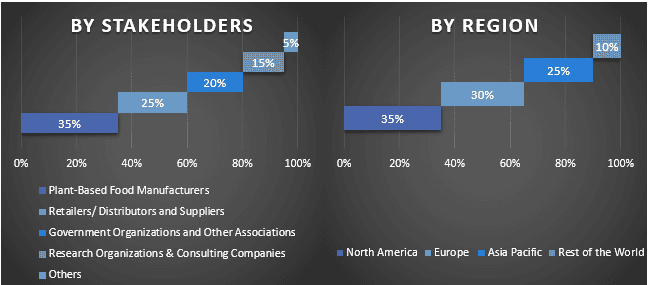
시장 엔지니어링
전반적인 시장 추정을 완료하고 글로벌 식물성 식품 시장의 각 세그먼트 및 하위 세그먼트에 대한 정확한 통계 수치를 얻기 위해 데이터 삼각 측량 기술이 사용되었습니다. 글로벌 식물성 식품 시장의 제품, 응용 분야 및 소스 분야의 다양한 매개변수와 추세를 연구한 후 데이터를 여러 세그먼트 및 하위 세그먼트로 분할했습니다.
글로벌 식물성 식품 시장 연구의 주요 목표
글로벌 식물성 식품 시장의 현재 및 미래 시장 동향이 연구에서 정확히 지적되었습니다. 투자자는 연구에서 수행된 질적 및 양적 분석을 기반으로 투자를 위한 재량권을 갖기 위한 전략적 통찰력을 얻을 수 있습니다. 현재 및 미래 시장 동향은 지역 수준에서 시장의 전반적인 매력을 결정하여 산업 참여자가 아직 개척되지 않은 시장을 활용하여 퍼스트 무버 이점을 얻을 수 있는 플랫폼을 제공했습니다. 연구의 다른 양적 목표는 다음과 같습니다.
- 가치(USD) 측면에서 식물성 식품 시장의 현재 및 예측 시장 규모를 분석합니다. 또한, 다양한 세그먼트 및 하위 세그먼트의 현재 및 예측 시장 규모를 분석합니다.
- 연구의 세그먼트에는 제품, 응용 분야 및 소스 영역이 포함됩니다.
- 식물성 식품에 대한 규제 프레임워크의 정의 및 분석
- 다양한 중개인의 존재와 관련된 가치 사슬을 분석하고, 업계의 고객 및 경쟁자 행동을 분석합니다.
- 주요 지역에 대한 식물성 식품 시장의 현재 및 예측 시장 규모를 분석합니다.
- 보고서에서 연구된 지역의 주요 국가에는 아시아 태평양, 유럽, 북미 및 기타 지역이 포함됩니다.
- 식물성 식품 시장의 회사 프로필과 빠르게 성장하는 시장에서 지속하기 위해 시장 참여자가 채택한 성장 전략
- 업계의 심층적인 지역 수준 분석
관련 보고서
이 상품을 구매한 고객님들도 함께 구매하신 상품


